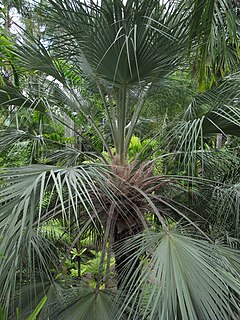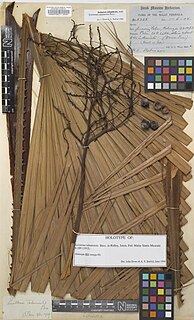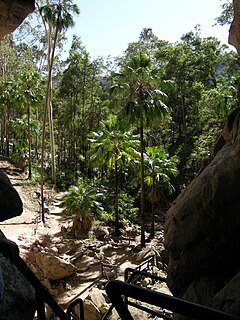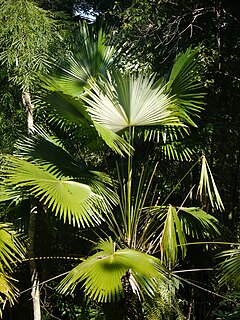
Palm Beach is a suburb in the Northern Beaches region of Sydney, in the state of New South Wales, Australia. Palm Beach is located 41 kilometres (25 mi) north of the Sydney central business district, in the local government area of Northern Beaches Council. Palm Beach sits on a peninsula at the end of Barrenjoey Road, between Pittwater and Broken Bay. The population of Palm Beach was 1,593 as at the 2016 census.

Livistona is a genus of palms, the botanical family Arecaceae, native to southeastern and eastern Asia, Australasia, and the Horn of Africa. They are fan palms, the leaves with an armed petiole terminating in a rounded, costapalmate fan of numerous leaflets.
Cabbage palm is a common name for several species of palms or palm-like plants:

Livistona australis, the cabbage-tree palm, is a plant species in the family Arecaceae. It is a tall, slender palm growing up to about 25 m in height and 0.35 m diameter. It is crowned with dark, glossy green leaves on petioles 2 m long. It has leaves plaited like a fan; the cabbage of these is small but sweet. In summer it bears flower spikes with sprigs of cream-white flowers. The trees accumulate dead fronds or leaves, which when the plant is in cultivation are often removed by an arborist.

Livistona alfredii, the millstream palm or millstream fan palm, is a species of flowering plant in the family Arecaceae. It is found only in the north-west of Western Australia where it is threatened by habitat loss.
Livistona endauensis is a species of palm tree of the genus Livistona. It is a tree endemic to Peninsular Malaysia. It has been called Endau fan palm in English. In Malay the palm is known as bertam or serdang Endau.

Livistona mariae, also known as the central Australian or red cabbage palm, is a species of flowering plant in the family Arecaceae.

Livistona tahanensis is a species of medium-sized palm tree of the genus Livistona, found on only one mountain top in Pahang, Peninsular Malaysia. In Malay the palm is known as Tahan serdang, or as daun tau.
Fulvous is a colour, sometimes described as dull orange, brownish-yellow or tawny; it can also be likened to a variation of buff, beige or butterscotch. As an adjective it is used in the names of many species of birds, and occasionally other animals, to describe their appearance. It is also used as in mycology to describe fungi with greater colour specificity, specifically the pigmentation of the surface cuticle, the broken flesh and the spores en masse.

Livistona saribus, also known as taraw palm in English, is a species of palm tree found in tropical Southeast Asia.

Cephrenes trichopepla, the yellow palm dart, is a butterfly of the family Hesperiidae. It is found in Australia, Papua and Papua New Guinea. It has recently been recorded from Singapore and Sri Lanka.

Livistona chinensis, the Chinese fan palm or fountain palm, is a species of subtropical palm tree of east Asia. It is native to southern Japan, Taiwan, the Ryukyu Islands, southeastern China and Hainan. It is also reportedly naturalized in South Africa, Mauritius, Réunion, the Andaman Islands, Java, New Caledonia, Micronesia, Hawaii, Florida, Bermuda, Puerto Rico and the Dominican Republic.

Livistona decora is a species of palm endemic to the sclerophyll woodlands of Queensland, Australia. It is known only from Magnetic Island near the City of Townsville, and south along the coast as far as Rainbow Beach. The species is now widely cultivated in arid regions worldwide as a decorative plant.

Saribus woodfordii is a species of fan palm which is native to an area from southeastern Papua New Guinea to the Solomon Islands.

Livistona humilis, the sand palm, is an Australian plant species of the family Arecaceae. It is a small, slender palm, growing to about 7 m tall and 5–8 cm dbh. It has 8 to 15 fan-shaped leaves, 30–50 cm long with petioles 40–70 cm long. It is endemic to the Top End of the Northern Territory in Australia. Genetic investigation suggests that its closest relation is Livistona inermis. This palm is fire tolerant and usually grows in environments where it is exposed to frequent fires.

Trachycarpeae is a tribe of palms in subfamily Coryphoideae of the plant family Arecaceae. It has the widest distribution of any tribe in Coryphoideae and is found on all continents, though the greatest concentration of species is in Southeast Asia. Trachycarpeae includes palms from both tropical and subtropical zones; the northernmost naturally-occurring palm is a member of this tribe. Several genera can be found in cultivation in temperate areas, for example species of Trachycarpus, Chamaerops, Rhapidophyllum and Washingtonia.

Anthony Norman Rodd, known as Tony Rodd, is an Australian botanist.

Livistona nitida, the Carnarvon Gorge cabbage palm, is a species of flowering plant in the family Arecaceae. It is endemic to Queensland in Australia.
John Leslie Dowe is an Australian botanist who specialises in palms.

Livistona jenkinsiana is a species of fan palm in the family Arecaceae.















